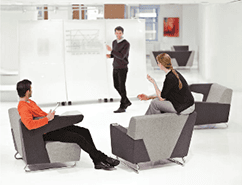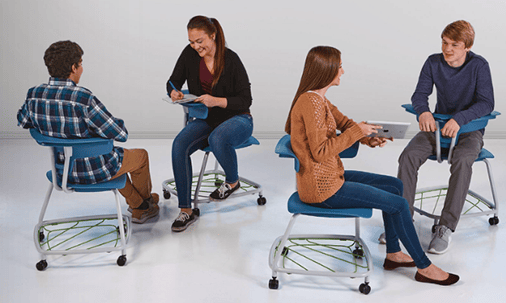- What's New
- Pricing & Purchasing
- Lead Times
- Literature & Samples
- Services & Warranties
- Careers
- Find a Rep
A Case - and Space - for Connection

By Jonathan Matta It happened again today. I saw a young couple eating together, with their heads down, phones in respective hands. They did not engage in any actual human-to-human correspondence, connection, or eye contact whatsoever. I did, however, overhear a whole lot of dings and beeps from their phones.
It happened again today. I saw a young couple eating together, with their heads down, phones in respective hands. They did not engage in any actual human-to-human correspondence, connection, or eye contact whatsoever. I did, however, overhear a whole lot of dings and beeps from their phones.
Is this what we've come to? Are the connections we make through our devices real? Do they empower us to actually gain new perspectives and make real, human-centered connections?
As we've pumped our schools and classrooms full of devices, have we unintentionally disconnected our children from one another?
The ease with which our world digitally connects today is worrisome. Those of us in the education community must consider it critically. We need to harness the power of physical space within our learning institutions-and design those spaces so that they can foment real, rewarding connections among students and teachers.

Empathy and Connection
That starts by employing “human-centered design” in our schools. It should go without saying that all spaces we design should be focused on the humans who occupy them. But all too often, it seems like we design spaces to accommodate the technology that will go in them.
Human-centered design starts with empathy and “perspective-taking.” By definition, empathy is “the feeling of being able to understand and share another person's experience and emotion.” It's something we seek to instill within our children.
Yet as we look to our learning environments, we don't always see built habitats that support empathy. Human-to-human connection is rooted in empathy. Unless we have shared or individually comparable experiences, it's nearly impossible for us to empathize with our peers, and thus to connect with them.
Digital Infrastructure and Self-Determination Theory
In 1985, two inventions hit the scene that to this day, are impacting our cultures and communities of learning. The first was the creation of the Domain Name System, or DNS. The DNS is the hierarchical naming system for computers, services, or any resource connected to the internet. In short, it's the foundation of everything-.com, .edu, .org, and beyond.
The second is an empirical theory that researchers Edward L. Deci and Richard Ryan updated called Self-Determination Theory, which holds that human beings need three basic things to be content: the need to feel competent in what one is doing, the need to feel authentic in one's life, and the need to feel connected to others. These needs are considered intrinsic-they far outweigh the extrinsic nature of the modern world.
Today's digital natives are biased toward a virtual form of connection that competes with this empirical theory. We seem to be pulling on both ends, like we are ripping apart a Stretch Armstrong doll. We are struggling, as humans, to relate, empathize, and connect with other humans. While digital integration has taken us one step forward in the classroom, it has forced us to take two steps backward, away from what we need to be intrinsically happy humans. Total Participation and Mindful Design
Total Participation and Mindful Design
Empathy can empower us to solve for the modern world's faulty form of “social” connection. When we as schools, designers, architects, and citizens organically collaborate and share experiences and emotion together, we can achieve something called Total Participation.
Think about the traditional learning experience-the one with straight rows, structured and linear curriculum and instruction, and a lot of “serve and consume.” The physical space that supports such an experience is the antithesis of a connected and empathetic student learning space.
So how do we build that connected and empathetic learning environment? By taking on the perspective of those who contribute to the learning expedition, we can begin to design environments that support the basic needs of Social Determination Theory. We empathize with the student. We empathize with the teacher, the faculty, and the administration. And we harness the power of physical space to achieve Total Participation.
Essential to this expedition is the understanding that what we create, what we make, is ours. Learning cultures are varied and are based on a number of intentional and unintentional variables-from the communities we live in to the cultures of our neighborhood, our cities, our region, and our nation.
Change Our Culture. Change Education.
We have the power to design the changes in our learning environments that we seek. In the pages that follow, we will see how space after space and place after place have already started to reimagine what their learning culture will be.
Of course, we won't all have the opportunity to start with a ground-up reimagination of our space, as these buildings do. That's okay. Start small. Start big. Ultimately, just start! It can be in a single classroom, or a commons, or a library. As long as the reimagination is clear, and defined through the design process, we know that, in time, learning paradigms will change. Just a single prototype can be the inspiration for a new, better one.
The conduit to connection awaits, and by empathizing with our students, teachers, and community, we can inspire a shift. We can foster real connections, ones that exist empowered by, rather than dependent, on technology. We can change our culture. We can change education.
Jonathan Matta, MBA, vice president of education at KI, champions a human-centered design mind-set and believes in the role that the physical space plays in activating and inspiring change in the future of learning. He is responsible for research and insight into the education marketplace, and works to guide both the KI team, along with K-12 and higher education institutions, on authentic design expeditions. Matta has spent time learning design at Stanford University's “d.school,” along with coursework from IDEO.